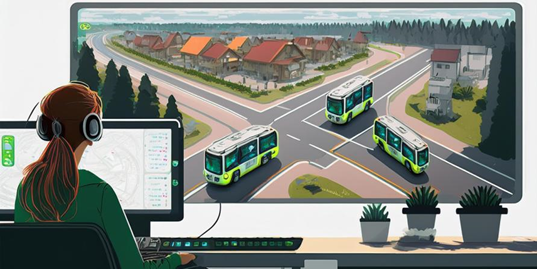- Home
- News Releases
- Back Issues
- June FY2025
- New International Standard for Remote Support for Low-Speed Automated Driving Systems Issued Based on Contributions from Japan
New International Standard for Remote Support for Low-Speed Automated Driving Systems Issued Based on Contributions from Japan
To Realize a Society Where People Can Move Around Freely (ISO 7856)
June 5, 2025
With its population rapidly aging and declining, it is vital for Japan to secure means of mobility for its people, such as driverless vehicles. The use of unmanned, safe, energy-efficient, low-speed automated driving (LSAD) systems provides an additional means of transportation for our society.
An international standard for remote support for low-speed automated driving systems (ISO 7856), for which Japan took the initiative in drafting, has been issued. ISO 7856 is expected to promote the social implementation of LSAD systems, contributing greatly to realizing a sustainable society in which anyone can travel freely.
1. Background
With the aging of its population and depopulation in regional communities advancing, Japan is confronted with the serious challenges of securing means of mobility in areas where it is difficult to maintain public transportation services and of overcoming a shortage of drivers.
Against this backdrop, an international standard for Remote Support for Low-Speed Automated Driving Systems (RS-LSADS) has been developed under the initiative of Japan. LSAD systems refer to a driverless, safe and energy-efficient means of transportation that operates at speeds not exceeding 32 km/h on predefined routes. As only a small number of operators is required to remotely support multiple vehicles, it is possible to provide automated driving services at a reduced cost.
2. Outline of the international standard
RS-LSADS allow operators located at a control center to remotely monitor vehicles via a communication system and to perform tasks such as the following:
- Providing information about any people or vehicles around a stop when the vehicle stops and restarts
- Performing remote driving operations, such as evacuating the vehicle to a safe location or stopping it when safe automated driving cannot be continued due to heavy rain or fog.
In order to fulfill these tasks, the system must be highly advanced in terms of perception of the situation around the vehicle as well as for timely information provision and driving operations.
The following key items are stipulated by ISO 7856:
- Requirements for vehicles, such as the detection range of in-vehicle cameras necessary for safe remote support
- Requirements for data and the quality of communication between vehicles and the control center
- Performance test procedures to confirm that these requirements are satisfied

This standard was officially issued as an international standard1 on June 3, 2025, after being deliberated by Working Group 14: Vehicle/ Roadway Warming and Control Systems (WG14) under the International Organization for Standardization (ISO)’s Technical Committee on Intelligent Transport Systems (TC204), based on the results of the Project on Research, Development, Demonstration and Deployment (RDD&D) of Automated Driving toward the Level 4 and its Enhanced Mobility Services (RoAD to the L4).
3. Expected effects
RS-LSADS should facilitate the provision of safe, energy-efficient automated driving services and help secure mobility in regional communities and overcome driver shortages in Japan as its population ages and declines.
Demonstration projects for LSAD systems are underway worldwide with a view to early realization of a transport system based on vehicles equipped with a Level 42 automated driving system. This standard is expected not only to accelerate these demonstration projects but also to promote the social implementation of safe and energy-efficient LSAD systems, thereby contributing greatly to a sustainable society where people can move around freely.
1: Official designation of the standard: ISO 7856 Intelligent transport systems — Remote support for low-speed automated driving systems(RS-LSADS)— Performance requirements, system requirements and performance test procedures
2: A state in which an automated operation system works as an alternative to handle the entire driving operation in a limited area and under the specific conditions of a running environment.
Related Links
- RoAD to the L4, Project on Research, Development, Demonstration and Deployment (RDD&D) of Automated Driving toward the Level 4 and its Enhanced Mobility Services
- International Organization for Standardization

- ITS Standardization Activities of ISO/TC 204 2024, Society of Automotive Engineers of Japan, Inc.

Divisions in Charge
Information on international standards
International Standardization Division, Innovation and Environment Policy Bureau
Information on automobile policies
Automobile Division, Manufacturing Industries Bureau